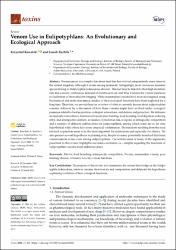| License | This is an open access article distributed under the terms and conditions of the Creative Commons Attribution (CC BY) license. | es |
| Author | Kowalski, Krzysztof | |
| Author | Rychlik, Leszek | |
| Accessioned date | 2024-09-13T22:58:02Z | |
| Available date | 2024-09-13T22:58:02Z | |
| Year | 2021 | |
| Citation | Kowalski, K., & Rychlik, L. (2021). Venom use in eulipotyphlans: an evolutionary and ecological approach. Toxins, 13(3), 231. Recuperado de: | es |
| URI | https://bvearmb.do/handle/123456789/5135 | |
| Abstract | Venomousness is a complex functional trait that has evolved independently many times in the animal kingdom, although it is rare among mammals. Intriguingly, most venomous mammal species belong to Eulipotyphla (solenodons, shrews). This fact may be linked to their high metabolic rate and a nearly continuous demand of nutritious food, and thus it relates the venom functions to facilitation of their efficient foraging. While mammalian venoms have been investigated using biochemical and molecular assays, studies of their ecological functions have been neglected for a long time. Therefore, we provide here an overview of what is currently known about eulipotyphlan venoms, followed by a discussion of how these venoms might have evolved under ecological pressures related to food acquisition, ecological interactions, and defense and protection. We delineate six mutually nonexclusive functions of venom (prey hunting, food hoarding, food digestion, reducing intra- and interspecific conflicts, avoidance of predation risk, weapons in intraspecific competition) and a number of different subfunctions for eulipotyphlans, among which some are so far only hypothetical while others have some empirical confirmation. The functions resulting from the need for food acquisition seem to be the most important for solenodons and especially for shrews. We also present several hypotheses explaining why, despite so many potentially beneficial functions, venomousness is rare even among eulipotyphlans. The tentativeness of many of the arguments presented in this review highlights our main conclusion, i.e., insights regarding the functions of eulipotyphlan venoms merit additional study. | es |
| Language | Spanish | es |
| Published | Toxins, 13(3), 231 | es |
| Rights | © 2021 by the authors. Licensee MDPI, Basel, Switzerland. | es |
| Rights URI | https:// creativecommons.org/licenses/by/ 4.0/ | es |
| Subject | Biodiversidad - República Dominicana | es |
| Subject | Fauna ─ República Dominicana | es |
| Subject | Hábitats y especies | es |
| Title | Venom use in eulipotyphlans : an evolutionary and ecological approach | es |
| dc.identifier.doi | https://doi.org/10.3390/toxins13030231 | |
| Material type | Article | es |
| Type of content | Scientific research | es |
| Access | Open | es |
| Audience | Technicians, professionals and scientists | es |


